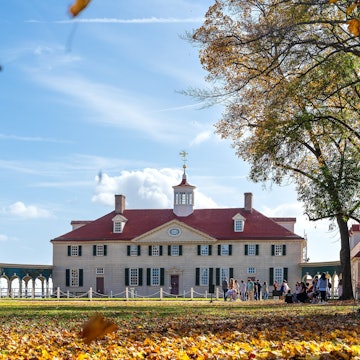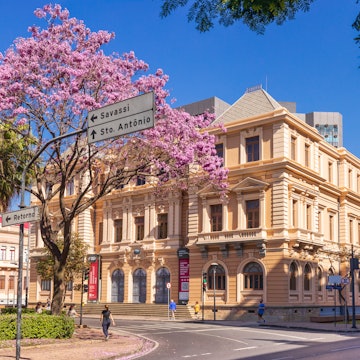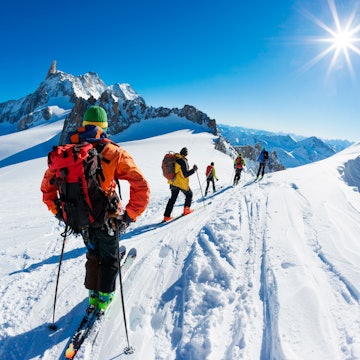
Explore the cultural wonders of Japan’s Bandai-Asahi National Park
Sponsored by

Sep 8, 2021 • 6 min read

Bandai-Asahi has the ability to delight and inspire at every turn © David McElhinney / Lonely Planet
Bandai-Asahi National Park, which spans Yamagata, Fukushima and Niigata Prefectures in northern Japan, is a region strong in traditional Japanese culture. From the yamabushi (mountain monks) of the syncretic Japanese religion, Shugendo, to the perception-warping art of bonsai, Bandai-Asahi has the ability to delight and inspire at every turn. Read on for our three-day itinerary for exploring the cultural wonders of Bandai-Asahi National Park.

Day 1 – Morning
Kick off your journey in Fukushima City, about a 90-minute Shinkansen (bullet train) from Tokyo Station. At the foot of the Azuma Mountain Range west of Fukushima, you’ll find Bonsai Abe, a classic Japanese home fronted by a garden of miniature pine trees called Azuma Goyomatsu that’ll make you feel like a giant roaming through a forest.
Seeds of Azuma Goyomatsu pines are foraged from the nearby mountains by third-generation artisan Daiki Abe, before he painstakingly cultivates them into the bonsai which populate the property. Book a tour of Bonsai Abe’s shop, accompanied by a bonsai workshop and a light meal of sticky rice with kinako (soybean flour) and fresh seasonal fruit with Japanese pickles. (Translator or English-speaking guide recommended.)
During the workshop, you’ll learn about the history of Abe’s unique method of bonsai cultivation which preserves the trees’ connection to nature. Abe bonsai are crafted to look as though they’ve grown in the nearby mountains and bear the scars of extreme weather and erosion that such an upbringing would entail. It’s hoped the image of the pine tree surviving in a harsh natural environment will inspire the viewer to do his or her best as well.
Day 1 – Afternoon
After the Bonsai experience, head to Lake Inawashiro, also known as “Heavenly Mirror Lake,” the largest body of water in Bandai-Asahi National Park. The train journey from Fukushima Station to Inawashiro Station via Koriyama will take around 90 mins.
Lake Inawashiro was formed between 40,000-90,000 years ago (theories vary), and provides some of the best views of Mt. Bandai, which erupted violently in 1888. The cool waters of the lake make it a popular spot for swimming in the hot summer months – you can also rent swan-shaped pedalos from the Shidahama Beach section. Or, rent a bicycle to ride around the lake via a roughly 37-mile route hugging the shoreline. (Campsite accommodation is also available.)
Day 1 – Evening
From there, it’s back on the train to Aizu-Wakamatsu, a 30-minute ride from Inawashiro Station. Aizu-Wakamatsu was a former samurai stronghold and the site of a fierce 19th-century battle of Aizu, and is still home to Aizu Tsuruga Castle – a multi-tiered edifice first constructed in the 1300s. Next to it is Fukushima museum, with ancient artifacts on display.
While you’re in the city, go for a stroll along the Nanoka-machi-dori old town quarter, where wood-latticed shops sell traditional Japanese crafts, before chowing down on marbled Aizu wagyu beef for dinner. La Raison is a popular option for European-style beef, whereas Gyu Zou is a better fit for the japanese traditionalists.
For accommodation there are a range of business hotels in the city, or for something more refined, head to ryokan (traditional inns) in the Higashiyama onsen (hot spring) district, such as Shosuke no Yado Takinoyu (breakfast and dinner included).

Day 2 – Morning
Return to Inawashiro Station via train, then take a bus to Bandaikogen in the Bandai Highlands (40 minutes in total). Go for a casual stroll around Goshikinuma, a marshland where each body of water has its own distinct character, from looking-glass lakes to otherworldly and vividly colored ponds.
For a longer sojourn you can tackle the roughly 20-mile track called ‘
Day 2 – afternoon
Following your hike, retrace your steps to Koriyama via Inawashiro Station (around one hour and 40 minutes). If you have time, go for a stroll around the lively city of Koriyama – Fukushima’s second largest – while stopping by at the pretty temple and landscape garden of Nyohou-ji. If you’re hungry, Koriyama has some excellent culinary fare: nip into Shogatsuso for carp sashimi or Moumoutei for Wagyu barbecue.
Before dark, hop back on the train toward your final destination for the day: Yonezawa in Yamagata Prefecture, a district of bubbling hot springs, centuries-old traditional ryokan, and some of the finest nihonshu (sake) in Japan. To get there, take a train to Yonezawa Station, where you’ll switch to a bus for Shirabu Onsen (total journey is around 90 minutes).
Day 2 – Evening
Relax in a more-than-700-year-old hot spring at Shirabu Onsen Nakaya Bekkan Fudokaku, a mountainside ryokan where the proprietor is the 27th generation to run the family business. A kaiseki ryori (traditional cuisine) dinner of seasonal sashimi, locally grown vegetables, and signature Yonezawa beef is included in the price – as is a classic Japanese rice-and-fish breakfast with green tea the following morning.

Day 3 – Morning and Afternoon
Leave early the next morning, or rent a car with a translator or English-speaking guide. The journey to your next stop, the Ideha Cultural Museum at the foot of Mt. Haguro, is around five hours on public transport. By car it’s approximately two-and-a-half hours.
Go for a wander around the museum, where old-world relics and artistic centerpieces detail the sacred history of Mt. Haguro. When done perusing the exhibits, you can walk in the fabled footsteps of the Shugendo yamabushi (ascetic hermits) accompanied by a practitioner of the 1,400-year-old religious sect. Dress up in all-white yamabushi attire before an ascetic hermit guides you along the 2,446 stone steps of Mt. Haguro – one of the Dewa Sanzan (three mountains of Dewa). At just 414-meters-tall, Mt. Haguro is the smallest of the Dewa Sanzan, so it’s accessible to hikers all year.
Whether the cedar-lined trail is swarmed with moss and singing with cicadas in summer or cloaked in snow at winter, it makes for one of the most beautiful spiritual walks in the country. A five-storied pagoda, a mountain-top shrine with a sweeping thatched roof, and miniature statues depicting jizo (the Buddhist protector of travelers and souls of the unborn) align the trail.
If you’re ready for a bite to eat, a couple of traditional chaya (tea houses) top the mountain trail where you can enjoy freshly made matcha while tucking into wagashi (traditional Japanese sweets) – a favorite among traveling pilgrims. Rounding off your spiritual journey, the ascetic hermits will then guide you through a session of zazen meditation in a rock garden punctuated by the sounds of sighing trees and croaking frogs.
Day 3 – Evening
Head to Hagurokan in the evening, a ten-minute stroll from the Ideha Cultural Museum. This old Japanese inn sits in the heart of the Dewa Sanzan region and has been welcoming pilgrims to Mt. Haguro-san for centuries. Keeping with the traditional theme of the day, Hagurokan features minimalist tatami interiors, and has a dinner and breakfast plan using home-grown ingredients.
Alternatively, take a 50-minute bus to Tsuruoka Station where you’ll find some classy ryokan and public onsen on the Yunohama seafront – Isagoya is one of the most popular in the area with accommodation options that include a rotenburo (private outdoor bath). It’s the perfect way to relax and reflect on your three-day exploration of traditional Japanese nature and culture. From Tsuruoka Station, you can take a four-hour Shinkansen back to Tokyo via Niigata Station the following day.
For more information, visit Bandai-Asahi National Park at the website of the National Parks of Japan
Sponsored by Japan Ministry of the Environment
As a travel entertainment and inspirational media outlet, we sometimes incorporate brand sponsors into our efforts. This activity is clearly labeled across our platforms.
This story was crafted collaboratively between Japan Ministry of the Environment and Lonely Planet. Both parties provided research and curated content to produce this story. We disclose when information isn’t ours.
With sponsored content, both Lonely Planet and our brand partners have specific responsibilities:
-
Brand partner
Determines the concept, provides briefing, research material, and may provide feedback.
-
Lonely Planet
We provide expertise, firsthand insights, and verify with third-party sources when needed.














